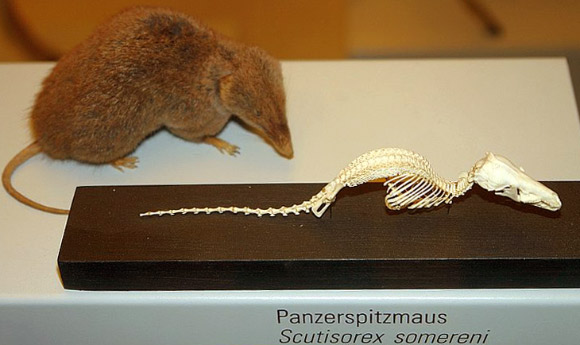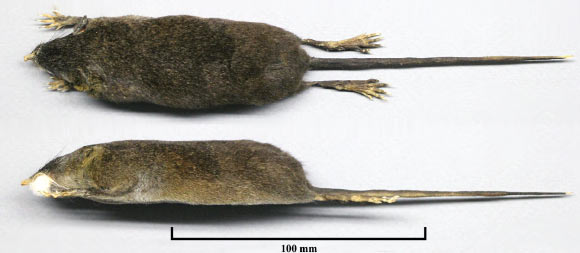A large team of biologists from the United States, the Democratic Republic of Congo, Belgium and Germany, has reported the discovery of a new shrew species in the equatorial Africa.

Scutisorex somereni at University of Zürich’s Paleontological Museum (Peter Spelt / CC BY-SA 3.0)
Before the discovery, science knew only one species of hero shrew – Scutisorex somereni, the mammal with the most bizarre lower spine on our planet.
Scutisorex somereni, also known the armored shrew, was discovered in 1910. Its most notable feature was not revealed for another 7 years, when a specimen was dissected to reveal the most peculiar backbone of any mammal.
The hero shrew measures about 5 – 6 inches (12 – 15 cm) and weighs up to 115 g. Its remarkable spine is unique among mammals, in that the lower vertebrae have multiple lateral processes that interlock with the processes of neighboring vertebra. The arrangement, along with surrounding musculature, affords the animal extraordinary strength, so much so that the hero shrew has traditionally been worn as a talisman.
The newly discovered species, named Scutisorex thori, represents a possible intermediate between Scutisorex somereni and other shrews, since is possesses an interlocking spine, but with fewer lower vertebrae and lateral processes than Scutisorex somereni. The suggested common name of the new species is the Thor’s hero shrew.
The only specimen of the Thor’s hero shrew was collected in the lowland forest near the Tshuapa River in the Democratic Republic of Congo.
“This shrew first came to light when explorers came to the eastern part of the Democratic Republic of Congo,” explained Dr William Stanley from Field Museum of Natural History, Chicago, who is a lead author of a study published in the journal Biology Letters.
“The explorers watched in amazement as a full-grown man stood on the back of the hero shrew, and the animal walked away, unharmed.”
The team presents a novel hypothesis for the functional significance of the spine of Scutisorex thori.
The scientists suggest that these shrews position themselves between the trunk and leaf bases of palms, and use their unique spine to exert force and gain access to concentrated sources of beetle larvae that are otherwise protected from predation. The same adaptation may allow these animals to lift logs or rocks to access invertebrates – a food resource that remains unavailable to many other mammals.
______
Bibliographic information: Stanley WT et al. 2013. A new hero emerges: another exceptional mammalian spine and its potential adaptive significance. Biol. Lett., vol. 9, no. 5; doi: 10.1098/rsbl.2013.0486








